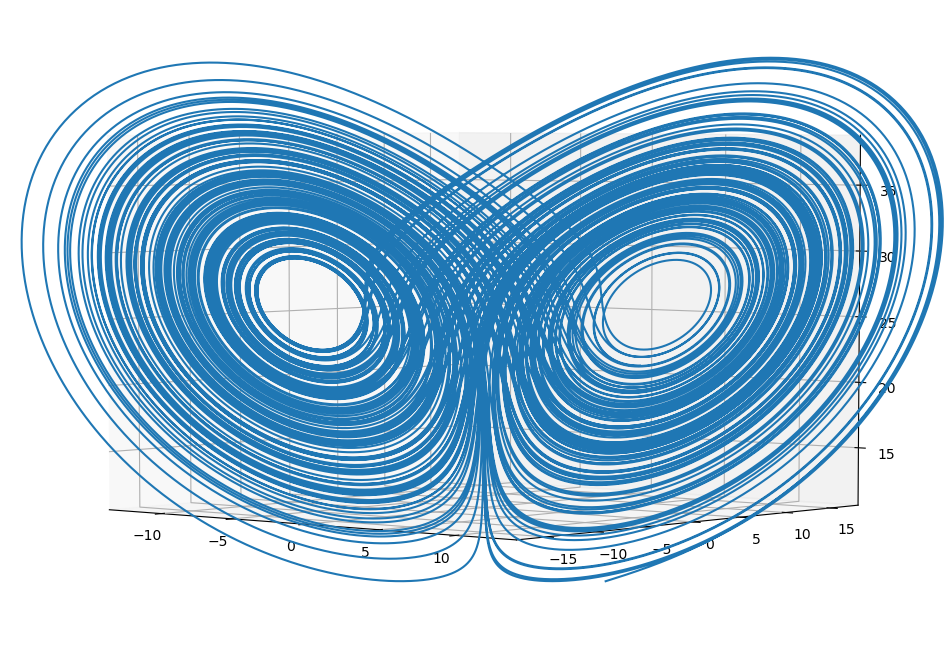这里使用 C++ 计算轨迹,生成 Python 文件,使用 matplotlib 绘图。
1 // simulator.cpp : 此文件包含 "main" 函数。程序执行将在此处开始并结束。 2 // 3 4 #include "pch.h" //预编译头,自行添加相关头文件 5 6 struct vec 7 { 8 double x; 9 double y; 10 double z; 11 }; 12 13 vec operator*(vec v, double n) 14 { 15 return { v.x * n , v.y * n , v.z * n}; 16 } 17 18 vec operator+(vec &x, vec &y) 19 { 20 return {x.x + y.x, x.y + y.y, x.z + y.z}; 21 } 22 23 //参数 24 double a = 11; 25 double b = 27; 26 double c = 2; 27 28 vec velocity(vec &pos) 29 { 30 vec velocity; 31 velocity.x = a * (pos.y - pos.x); 32 velocity.y = pos.x * (b - pos.z) - pos.y; 33 velocity.z = pos.x * pos.y - c * pos.z; 34 35 return velocity; 36 } 37 38 //时间微元 39 double dt = 0.001; 40 41 int main() 42 { 43 std::vector<vec> state; 44 45 //初始条件 46 vec init_state = { 5.0, 5.0 , 5.0}; 47 48 vec p = init_state; 49 50 int ii = 200000; 51 for (int i = 0; i < ii; ++i) 52 { 53 vec v = velocity(p); 54 vec dp = v * dt; 55 p = p + dp; 56 state.push_back(p); 57 printf("\r[%2.1lf%%|%5d] p -> (%lf,%lf,%lf)", (double)i / ii * 100, i, p.x, p.y, p.z); 58 } 59 60 printf("\n\nsaving..."); 61 62 //输出python文件 63 64 std::ostringstream ox; 65 std::ostringstream oy; 66 std::ostringstream oz; 67 68 ox << "["; 69 oy << "["; 70 oz << "["; 71 72 for (size_t i = 0; i < state.size(); ++i) 73 { 74 ox << state[i].x; 75 oy << state[i].y; 76 oz << state[i].z; 77 78 ox << ","; 79 oy << ","; 80 oz << ","; 81 82 if ((i + 1) % 10 == 0) 83 { 84 ox << std::endl; 85 oy << std::endl; 86 oz << std::endl; 87 } 88 } 89 90 ox << "]"; 91 oy << "]"; 92 oz << "]"; 93 94 std::ofstream f; 95 f.open("output.py"); 96 97 f << "import numpy as np" << std::endl; 98 f << "import matplotlib.pyplot as plt" << std::endl; 99 f << "from mpl_toolkits.mplot3d import Axes3D" << std::endl; 100 101 f << "x = " << ox.str(); 102 f << std::endl; 103 f << "y = " << oy.str(); 104 f << std::endl; 105 f << "z = " << oz.str(); 106 f << std::endl; 107 108 f << "X = np.array(x)" << std::endl; 109 f << "Y = np.array(y)" << std::endl; 110 f << "Z = np.array(z)" << std::endl; 111 112 f << std::endl; 113 114 // f << "" << std::endl; 115 f << "fig = plt.figure()" << std::endl; 116 f << "ax = Axes3D(fig)" << std::endl; 117 f << "ax.plot(X, Y, Z)" << std::endl; 118 f << "plt.show()" << std::endl; 119 f << "" << std::endl; 120 121 f.close(); 122 }
然后会输出 output.py
依赖的包有:numpy, matplotlib
然后直接执行 >python output.py即可
结果:
